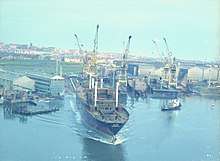Austin & Pickersgill
.jpg) Southwick Yard, 1961 | |
| Industry | Shipbuilding |
|---|---|
| Founded | 1954 (as Austin & Pickersgill) |
| Headquarters | |
History
Corporate history

Austin & Pickersgill was formed in Sunderland in 1954 by the merger of S.P. Austin & Son Ltd (founded by Samuel Peter Austin in c.1826) and William Pickersgill & Sons Ltd (founded c. 1838).[1] After the merger Austin's Wear Dock yard was used for repair while shipbuilding was concentrated at Pickersgill's Southwick Yard. The latter was modernised with the introduction of large assembly shops and prefabrication processes.[1] This reduced costs and increased the maximum size of a vessel that the yard could build from 10,000 to 40,000 tons deadweight.
In 1957 a consortium of three companies led by London & Overseas Freighters Ltd. (LOF) took over Austin & Pickersgill.[2] In October 1968 Austin & Pickersgill took over Bartram & Sons Ltd, whose South Dock yard was also in Sunderland.[1] In 1970 London and Overseas Freighters bought out the other members of the consortium to take 100% ownership of Austin & Pickersgill.
In 1977 Austin & Pickersgill was nationalised as a member company of British Shipbuilders.[3] In 1986 the Company was merged with Sunderland Shipbuilders Ltd to form North East Shipbuilders Ltd.[4] However both the Southwick and the Doxford Pallion Shipbuilding Yards closed in 1988 following negotiations with the European Commission to reduce shipbuilding capacity in the UK.[5]
Ship Production
.jpg)
A&P maximised the competitiveness of its prefabrication process by producing ships to standard designs rather than individual specifications. From 1962 onwards the company offered standard bulk carriers in a range of sizes designated according to tonnage.

A&P's most numerous product was another of its standard designs, the SD14 shelter deck cargo ship. During the Second World War, shipyards in the United States had delivered more than 2,700 Liberty ship shelter deck cargo ships.[6] By the 1960s many Liberty ships were reaching the end of their service lives, so in 1965 A&P started to develop a low-cost shelter-deck cargo vessel to replace them.[6]
A&P invited other UK shipbuilders to tender for licences to produce SD14's, but by 1966 only Bartram's could meet A&P's requirement to build each ship to a selling price of £915,000. Both Bartram's and A&P built their first SD14's in 1967[1] and handed them to their new owners in February 1968. A&P's takeover of Bartram's followed in October.[1]
In 1967 A&P licensed Hellenic Shipyards Co. of Skaramangas in Greece to build twenty SD14's. In 1971 A&P licensed Companhia Comércio e Navegação to build SD14's at Mauá in Brazil.
In 1973 Robb Caledon Shipbuilding of Dundee in Scotland contracted to build three SD14's. Astilleros y Fábricas Navales del Estado also obtained permission to build six SD14's in its yard at Ensenada in Argentina.
By the time production ceased, 211 SD14's had been built either at A&P's Southwick and South Dock yards and or by licencees in Greece, Brazil, Scotland and Argentina.[6] The largest volume of sales was to Greek shipowners.[6] The SD14 and B-series standard ship designs, and the prefabrication methods by which they were built enabled A&P to maintain a full order book until nationalisation in 1977, in contrast to many other UK shipbuilders in that era.
See also
References
- "Shipbuilding on the Wear". Archived from the original on 13 April 2014. Retrieved 10 April 2014.
- London & Overseas Freighters
- What was the last nationalisation? BBC News, 18 February 2008
- Tyne & Wear Archives Archived 3 November 2013 at the Wayback Machine
- Last shipyard BBC News, 28 November 2008
- Old timers can't contain their enthusiasm as SD14 workhorse remains a model of success Cape Times, 3 August 2005
Further reading
- Lingwood, John (1976). SD14 The Great British Shipbuilding Success Story. Kendal: World Ship Society. ISBN 0-9500044-8-0.
- Lingwood, John (2004). SD14: The Full Story. Focus. ISBN 978-1-901703-64-1.
- Ritchie, LA (1992). The Shipbuilding Industry, a guide to historical records. Manchester: Manchester University Press.
- For details of the company archives see Tyne & Wear Archives Service